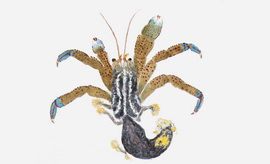Drawing Nature
What can you learn about crabs and their relatives from Dr Josephine Hart’s illustrations?
Dr Josephine F.L. Hart authored Crabs and their Relatives of British Columbia, a Royal BC Museum handbook that was published in 1982. In the book, Dr Hart carefully wrote about crabs and their marine cousins. She also included her own illustrations of the creatures in the book.
Many biologists are still trained in the art of scientific illustration. Drawing, unlike photography, allows a researcher to really highlight something about the plant, fungi or animal they are studying. Illustrating can emphasize key features in a way photography cannot.
There are many different kinds of drawings, too. They vary from simple black-and-white line drawings to stipple drawings (the use of dots to create an image) to realistic detailed depictions of an organism.
Today, most natural history publications use a combination of photographs and drawings. The most compelling images by Dr Hart in Crabs and their Relatives of British Columbia are watercolours.
Alcohol is often used to preserve and store wet specimens in the museum collection, but it drains the animals of their natural colour. That is another reason why vivid coloured illustrations can be valuable to researchers. They are not just beautiful pieces of art, but also record valuable information.
Dr Hart’s illustrations are so lovingly detailed that you can easily imagine that her scientific curiosity was fuelled by a deep love of the creatures she studied and illustrated.




